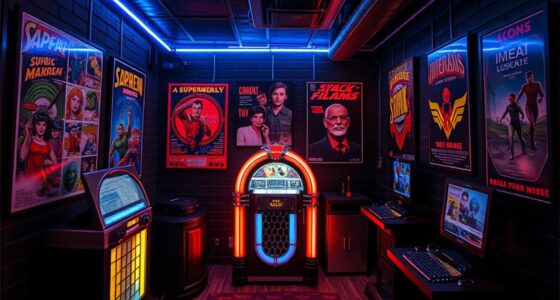Incorporating augmented reality into escape rooms allows you to blend digital and physical worlds seamlessly, making puzzles more immersive and engaging. AR adds virtual clues, characters, and overlays that interact with real objects, creating a richer storytelling experience. This technology can reduce the need for physical props while boosting puzzle complexity and realism. If you want to explore how AR can elevate your escape room, keep exploring to uncover all the exciting possibilities.
Key Takeaways
- Integrate virtual clues and overlays with physical objects to create immersive, seamless puzzles that enhance storytelling and engagement.
- Use AR characters and holographic images to provide hints, deepen narratives, and guide players through complex challenges.
- Overlay virtual maps and hidden messages onto real environments to streamline gameplay and reduce reliance on physical props.
- Ensure high-quality, real-time AR visuals with smooth interactions for a realistic and captivating experience.
- Design dynamic storylines that evolve based on player actions, leveraging AR to make each escape room uniquely responsive.

Augmented reality (AR) is revolutionizing escape rooms by blending digital elements with real-world environments, creating immersive and interactive experiences. When you step into an AR-enhanced escape room, you’re not just solving puzzles; you’re entering a world where virtual clues seamlessly integrate with the physical setting, heightening your sense of immersion. Instead of relying solely on traditional riddles and physical locks, AR introduces virtual overlays that reveal hidden clues or provide additional context, making every corner of the room a potential treasure trove of information. This technology allows you to interact with virtual objects as if they were part of the real environment, adding layers of complexity and engagement to the game. For example, a virtual map might hover over a table, highlighting key locations, or a virtual character could appear to offer hints, guiding you toward the next step.
AR enhances escape rooms with virtual clues and interactive overlays, creating immersive, seamless, and engaging puzzle experiences.
The use of virtual clues in AR escape rooms enhances immersive storytelling by transporting you into narratives that feel remarkably real. As you navigate through the room, AR elements can unfold storylines in real time, making the experience more compelling. You might see virtual journals that tell a story as you examine them, or holographic images that reveal secrets when viewed from certain angles. These virtual clues serve as storytelling devices, drawing you deeper into the plot and encouraging you to think creatively. Because AR can adapt to your actions, the story can evolve dynamically based on your choices, reinforcing a sense of agency and involvement. This level of interaction keeps you engaged and makes each escape room unique, as no two experiences are exactly the same. Additionally, high refresh rates ensure smooth visuals and reduce motion blur, enhancing the realism of virtual overlays.
Additionally, AR’s ability to layer virtual clues onto physical objects helps streamline the gameplay, reducing the need for cumbersome props or manual solutions. You can, for instance, scan a real painting to see a hidden message or unlock a virtual door by solving a puzzle displayed on your device. This integration makes the game feel more natural and less contrived, immersing you fully in the narrative. As you progress, the virtual clues build on each other, creating a cohesive story that feels alive and responsive to your actions. The immersive storytelling enabled by AR transforms a traditional escape room into a captivating adventure where digital and real-world elements coexist harmoniously, elevating the overall experience to new heights.
Frequently Asked Questions
What ARe the Costs Associated With Adding AR to Escape Rooms?
The costs of adding AR to escape rooms vary, but you should plan your budget carefully. Expect expenses for technology integration, including AR hardware like tablets or glasses, and software development. Additionally, consider ongoing costs for updates and maintenance. It is crucial to balance these expenses with your overall budget planning to guarantee the AR experience enhances your escape room without overspending or compromising quality.
How Do Players Typically Respond to Augmented Reality Features?
Your players usually respond to AR features with excitement and curiosity, as if they’ve unsealed a secret world. They find augmented reality boosts their engagement, making puzzles more immersive and interactive. Most embrace the technology quickly, driven by a sense of adventure and novelty. Their technological acceptance grows rapidly as AR transforms the escape room experience, creating a sense of wonder and making players enthusiastic to explore every digital detail you add.
What Equipment Is Necessary for Integrating AR Into Escape Rooms?
To integrate AR into escape rooms, you’ll need AR hardware like tablets, smartphones, or AR glasses, depending on your immersive design goals. Make sure your devices are compatible with your chosen software platform. You’ll also want to invest in high-quality visuals and interactive elements to create an engaging experience. Proper setup of sensors and markers enhances accuracy, making the AR integration seamless and immersive for players.
ARe There Safety Concerns With Using AR in Immersive Environments?
Like Pandora’s box, AR in escape rooms can open safety concerns if not managed properly. You should prioritize user safety by monitoring for accidents and ensuring devices don’t cause physical harm. Be mindful of privacy concerns, like data collection and location tracking. Clear instructions and safety guidelines help keep players secure, making the experience enjoyable and worry-free, while avoiding potential hazards associated with immersive AR environments.
How Can AR Enhance the Storytelling Aspect of Escape Rooms?
You can enhance the storytelling in escape rooms by using AR to introduce virtual characters and immersive environments. This technology makes your narrative more interactive, allowing you to guide players through a story with dynamic visuals and real-time clues. With AR, you create engaging interactive narratives that respond to players’ actions, heightening immersion and making the experience more memorable and personalized.
Conclusion
As you open the final puzzle, imagine how augmented reality transforms your escape room experience from a simple game into a daring adventure. Just like stepping through a portal to another world, AR immerses you in a universe where imagination becomes reality. It’s like turning a puzzle into a living story — one that keeps players captivated and enthusiastic to explore more. Embrace AR’s potential, and watch your escape room become an unforgettable, immersive journey.









